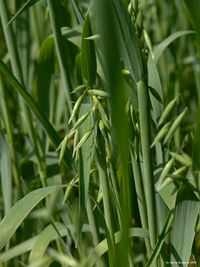Avena sativa
| See Also | Botanical Monographs |
|---|
Oats have always had the reputation as a wholesome, health food. The grain is a rich source of complex carbohydrates bused by the body for fuel. It has been used historically to support the immune system and as a nerve tonic. It is said that horses that eat wild oats are more likely to mate, hence the old saying sowing wild oats. To explore the characteristics, medicinal uses and prescribing considerations of this herb in more detail, check out the references indicated.[1], [2]
Contents
Characteristics
- Common Names: Oats
- Family: Poaceae
- Habitat: Avena may have been indigenous to Sicily, noted by Greeks and Romans, and is now cultivated in northern temperate latitudes.
- Parts Used: Seed, stripped of its fibrous covering (groats) and ground or rolled (oatmeal)
- Constituents: starch (59%), saccharo-mucilaginous (11%), albumen (4%), fiber and moisture (24%), avenin-nitrogenous compound soluble in ethanol, indole alkaloid (gramine), oat straw has pectin and silica
- Medicinal Actions: nervine, mild sedative, nutritive, analgesic, demulcent, tonic
Uses
Historical Uses:
Oats have always had the reputation as a wholesome, health food. The grain is a rich source of complex carbohydrates bused by the body for fuel. It has been used historically to support the immune system and as a nerve tonic. It is said that horses that eat wild oats are more likely to mate, hence the old saying sowing wild oats.
Medicinal Uses:
Internal
- Nerve Tonic
- nervous exhaustion and debility, cardiac weakness from nervous depression and debility, nervous headache from overwork and depression, nervous debility from convalescence
- opium, morphine, and nicotine withdrawal
- Other Conditions
- relapsing cardia rheumatism, spermatorrhea from debility, lung disease, spasm of the neck of the bladder, habitual constipation (as a gruel)
Topically
Prescribing Considerations
The information provided is intended to augment the treatment from a naturopathic doctor or other trained medical professional. Although most herbs are generally safe, it is recommended that you avoid self-prescribing especially when there is an underlying ongoing medical condition, if you are on any prescription medications or if you are pregnant or breastfeeding.
Formulations and Preparation
- Tincture - 1/2-2 drachms three times daily, 1-20 drops every 1-3 hours
- Fluid extract - 1/2-2 drachms three times daily
- Bath - 100g straw in 3L of water, simmer 20 minutes, add to bath water
- Nutritive gruel - 30g in 2L of water, boil down to 1L, then season with salt, fruit pulp (prunes, raisins) for convalescence from acute disease, puerperal state, chronic disease
1 drachm = 60 drops or 1 tsp or 1/8 of an ounce.
Safety
The safety and prescribing considerations for this herb include:[3], [4]
- Generally regarded as safe.
- Side-effects are generally not seen.
- Drug-Herb Interactions rare.
References
- ↑ Boon Heather, Smith Michael (2009) 55 Most Common Medicinal Herbs: The Complete Natural Medicine Guide Second Edition Institute of Naturopathic Education and Research, CCNM Toronto.
- ↑ Godfrey Anthony, Saunders Paul, Barlow Kerry, Gowan Matt (2011) Principles and Practices of Naturopathic Botanical Medicine, Advanced Botanical Medicine. V3 CCNM Press, Toronto.
- ↑ Stargrove Mitchell Bebell, Treasure Jonathan, McKee Dwight L (2008) Herb, Nutrient and Drug Interactions: Clinical Implications and Therapeutic Strategies
- ↑ Brinker Francis (1997) Herbal Contraindications and Drug Interactions: Plus Herbal Adjuncts With Medicines, 4th Edition Eclectic Medical Publications.
